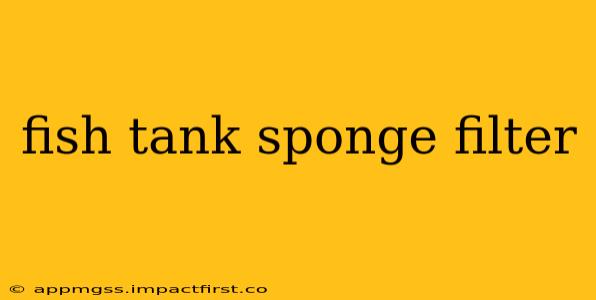A fish tank sponge filter is a cornerstone of any successful aquarium setup, offering a quiet, efficient, and cost-effective way to keep your aquatic environment clean and healthy. Unlike other filtration methods, sponge filters rely on the simple principle of mechanical filtration, offering a surprisingly effective solution for even the most demanding aquariums. This comprehensive guide delves into the world of sponge filters, exploring their benefits, drawbacks, and how to best utilize them for a thriving underwater ecosystem.
What are the benefits of using a sponge filter for my aquarium?
Sponge filters provide numerous advantages over other filtration systems, making them a popular choice among hobbyists and professionals alike. Their key benefits include:
- Gentle Water Flow: Sponge filters produce a gentle water flow, ideal for delicate fish species and fry that may be overwhelmed by the stronger currents of other filters.
- Biological Filtration: The porous nature of the sponge provides an ideal environment for beneficial bacteria to colonize. These bacteria break down harmful waste products like ammonia and nitrite, transforming them into less toxic nitrate. This biological filtration is crucial for maintaining water quality.
- Quiet Operation: Unlike power filters that can generate noise, sponge filters operate silently, creating a peaceful environment for both fish and owners.
- Low Maintenance: Regular rinsing (with aquarium water) is the primary maintenance requirement. They are extremely durable and require minimal replacement.
- Affordable: Sponge filters are typically much more affordable than other filter types, making them an accessible option for beginners and budget-conscious aquarists.
- Air-Driven Simplicity: Their reliance on an air pump eliminates the need for electricity (beyond the air pump itself) making them ideal for backup systems or less accessible locations.
How often should I clean my sponge filter?
Over-cleaning your sponge filter can disrupt the beneficial bacteria colonies vital for biological filtration. A good rule of thumb is to rinse the sponge gently in some of your aquarium water once a month (or more frequently for heavily stocked tanks). Never use tap water, soap, or bleach, as these will kill the beneficial bacteria. Simply squeeze the sponge gently to remove excess debris.
What happens if I clean my sponge filter too often?
Cleaning your sponge filter too often will remove the beneficial bacteria colonies essential for breaking down harmful waste products in your aquarium. This can lead to a spike in ammonia and nitrite levels, potentially causing illness or death in your fish.
Are sponge filters good for betta fish tanks?
Yes, sponge filters are an excellent choice for betta fish tanks. Their gentle water flow is perfect for these relatively sedentary fish, and the quiet operation contributes to a less stressful environment. The biological filtration provided by the sponge also helps maintain clean water, preventing the buildup of harmful ammonia and nitrite.
What size sponge filter do I need for my tank?
The appropriate size of a sponge filter depends on the size of your aquarium and the stocking level (number of fish). Larger tanks and higher stocking levels require larger sponge filters to maintain adequate filtration. Manufacturers often provide size recommendations based on tank capacity. It's always better to err on the side of slightly over-filtration rather than under-filtration.
Can I use a sponge filter in a planted tank?
Absolutely! Sponge filters are compatible with planted tanks. Their gentle water flow won't disturb the substrate or delicate plants. In fact, the beneficial bacteria that colonize the sponge contribute to a healthier planted tank environment.
How do I install a sponge filter?
Installing a sponge filter is generally straightforward. Most kits include an air pump, tubing, and the filter itself. Simply connect the air tubing to the air pump and the filter, then place the filter in your tank. The air pump will draw water through the sponge, providing filtration. The specific instructions may vary slightly depending on the brand and model of your sponge filter.
Are there any disadvantages to using a sponge filter?
While sponge filters offer many advantages, some drawbacks should be considered:
- Mechanical Filtration Only (primarily): They primarily filter out larger debris; they don't filter out very fine particles as efficiently as some other filter types.
- Limited Filtering Capacity: Their capacity is limited compared to more powerful filter systems. They are best suited for smaller to moderately sized tanks, or tanks with minimal bioload.
- Regular Cleaning is Required: While low-maintenance, regular cleaning is crucial to prevent clogging and maintain efficiency.
In conclusion, the fish tank sponge filter is a valuable asset to any aquarium owner. Its simplicity, efficiency, and cost-effectiveness make it a highly recommended filtration method, particularly for beginners or those seeking a low-maintenance yet highly effective solution for maintaining a healthy aquatic environment. Remember to choose a filter appropriate for your tank size and bioload, and maintain it according to the guidelines above for optimal performance.
